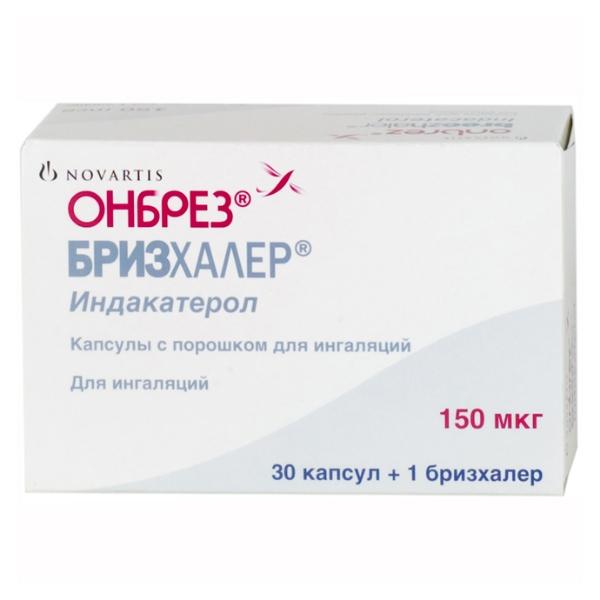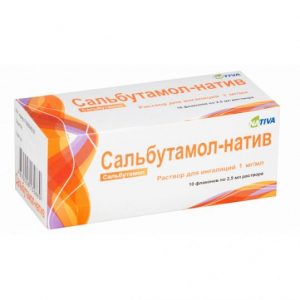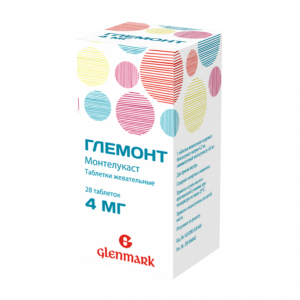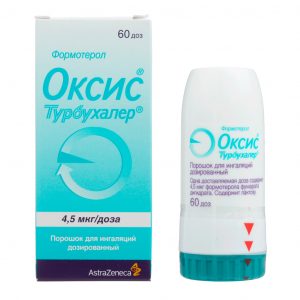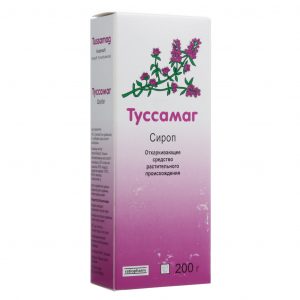Description
Latin name
Onbrez brizhaler
Release form
Capsules with powder.
Packing
30 pcs
Indications
Long-term maintenance therapy for bronchial obstruction in patients with COPD.
Contraindications
– age under 18 years (efficacy and safety not established)
– pregnancy
– breastfeeding
– hypersensitivity to any component of the drug.
Special instructions
Bronchial asthma
Due to the lack of data on the continued use of indacaterol in patients with bronchial asthma, the drug should not be used in this category of patients.
Paradoxical bronchospasm
Like any other inhalation therapy, the use of the drug can lead to the development of paradoxical bronchospasm, which threatens the patient’s life. In the event of a paradoxical bronchospasm, treatment with the drug should be stopped immediately and alternative therapy prescribed.
Deterioration of the underlying disease
The drug cannot be used to relieve acute bronchospasm, i.e. do not use as emergency therapy. In the event of a worsening of COPD during treatment with the drug, it is necessary to re-evaluate the patient’s condition and review the treatment regimen of the disease.
Effect on the cardiovascular system
In some patients, the drug Onbrez ® Breezhaler ®, like other agonists of 2-adrenergic receptors, can affect the cardiovascular system (increase heart rate, blood pressure). In case of adverse events, discontinuation of drug therapy may be required. Moreover, when using 2-adrenoreceptor agonists, the following electrocardiographic changes can be observed: flattening of the T wave, lengthening of the QT interval and depression of the ST segment (however, the clinical significance of these changes has not been established).
When using the drug in clinical trials (at recommended therapeutic doses), there was no significant lengthening of the QT interval compared with placebo.
Hypokalemia
In some patients, with the use of 2 -adrenoreceptor agonists, significant hypokalemia can occur, leading to the development of adverse events from the cardiovascular system. A decrease in serum potassium concentration is usually transient and does not require correction. In patients with severe COPD, hypokalemia may be exacerbated by hypoxia and concomitant therapy, which, in turn, may increase the likelihood of developing arrhythmias.
Hyperglycemia
Inhalation of high doses of 2 -adrenoreceptor agonists may increase plasma glucose levels. When using the drug in patients with diabetes, the plasma glucose concentration should be regularly monitored. In clinical studies in patients receiving the drug (in recommended doses), an increase in the incidence of clinically significant hyperglycemia was observed by an average of 1-2% compared with placebo. The effectiveness and safety of the drug in patients with uncompensated diabetes have not been studied.
Influence on the ability to drive vehicles and control mechanisms
There is no data on the effect of the drug Onbrez Brizkhaler on the ability to drive vehicles and work with mechanisms.
Composition
1 caps.: – indacaterol maleate 194 ?g, which corresponds to the content of indacaterol 150 ?g
Excipients: lactose monohydrate – 24.806 mg.
Composition of the capsule shell: gelatin – 49 mg, black ink (shellac (E904), iron dye black oxide (E172), purified water, propylene glycol (E1520)).
Dosage and administration
For inhalation only!
The drug is a capsule with powder for inhalation, which should be used only for inhalation through the mouth using a special device – Breezhaler, which is included in the kit. The drug can not be taken orally. Capsules with powder for inhalation should be stored in a blister and removed immediately before use. Inhalation of the drug is carried out daily 1 time / day at the same time. If inhalation is missed, the next day, Onbrez ® Brizkhaler ® is used at the usual time.
The recommended dose of the drug is 150 mcg (contents of 1 capsule 150 mcg) 1 time / day (1 inhalation per day). The dose of the drug can be increased only on the recommendation of a doctor.
Inhalation of the drug at a dose of 300 mcg (contents of 1 capsule 300 mcg) 1 time / day may provide an additional clinical effect in some patients, for example, patients with severe COPD.
Maximum dose – 300 mcg (contents of 1 capsule 300 mcg) 1 time / day (1 inhalation per day). The maximum allowable dose should not be exceeded.
Dosage adjustment is not required in patients aged 65 years and older, patients with mild to moderate impaired liver and kidney function.
Side effects of
When using the drug in therapeutic doses, the following adverse events were most often observed: nasopharyngitis, cough, upper respiratory tract infection and muscle cramps. Most of the above adverse events were mild or moderate, the frequency of development of these adverse events decreased with further use.
The following are adverse events observed with the use of the drug in doses of 150 and 300 micrograms 1 time / day. in patients with COPD. Adverse reactions are distributed according to the frequency of occurrence. The following criteria were used to estimate the frequency: very often (? 1/10) often (? 1/100, Infections and infestations: often – nasopharyngitis, upper respiratory tract infections, sinusitis.
From the respiratory system: often – cough, sore throat, rhinorrhea.
From the musculoskeletal system: often – muscle spasm, myalgia, bone pain.
From the nervous system: infrequently – dizziness, paresthesia.
From the cardiovascular system: often – coronary heart disease infrequently – atrial fibrillation.
From the digestive system: often – dry mouth.
Metabolic disorders: often hyperglycemia / newly diagnosed diabetes mellitus.
General disorders: often – peripheral edema, pain in the chest area (non-cardiogenic) infrequently – discomfort in the chest area.
When using the drug at a dose of 600 mcg 1 time / day, the safety profile did not differ significantly from that for inhalation of therapeutic doses (150 and 300 mcg 1 time / day). Additional adverse events were anemia and tremor. Muscle cramps and nasopharyngitis were also more frequently detected. In patients with COPD, when inhaled at the recommended doses, the drug does not have a clinically significant systemic? 2-adrenomimetic effect. Heart rate on average changed by no more than 1 beats per minute. The incidence of tachycardia (noted in rare cases), a significant lengthening of the QTc interval (> 450 ms for men and> 470 ms for women) and hypokalemia was similar to that with placebo.
Changes in plasma glucose concentration were similar to those in the placebo group.
In clinical trials within 15 seconds after drug inhalation in patients (in 17-20% of cases), the development of sporadic cough lasting about 5 seconds was observed. The occurrence of cough after inhalation of the drug Onbrez Brizkhaler slightly worried patients and did not require discontinuation of treatment with the drug (since cough is a symptom of COPD, and only in 6.6% of cases patients associated cough with the drug). There was no association between a cough observed immediately after inhalation of the drug and the development of bronchospasm, exacerbation of COPD, worsening of the course of COPD and a decrease in the effectiveness of the drug.
Drug interaction
Drugs that prolong the QT interval
As with other 2-adrenoreceptor agonists, QT interval may be prolonged during therapy with the drug. Since this effect of indacaterol on the length of the QT interval can be potentiated by other drugs, Onbrez ® Breezhaler ® should be used with caution in patients receiving MAO inhibitors, tricyclic antidepressants, or other drugs. lengthening the QT interval. Lengthening the QT interval increases the risk of ventricular arrhythmias.
Sympathomimetic drugs
The simultaneous use of indacaterol with sympathomimetics (both separately and as part of combination therapy) may increase the risk of adverse events.
The drug should not be used simultaneously with other long-acting 2-adrenoreceptor agonists or with drugs that include long-acting 2-adrenoreceptor agonists.
Hypokalemia
Concomitant use with methylxanthine derivatives, corticosteroids, or potassium-excreting diuretics can enhance possible hypokalemia caused by 2-adrenoreceptor agonists.
2-adrenergic receptor blockers
Since 2-adrenoreceptor blockers can weaken or inhibit the action of 2-adrenoreceptor agonists, Onbrez ® Breezhaler ® should not be used simultaneously with 2-adrenoreceptor blockers (including eye drops).
If it is necessary to use both classes of drugs, it is preferable to use cardioselective 2-adrenoreceptor blockers, however, they must be used with caution.
Interaction at the level of CYP3A4 isoenzyme and P-glycoprotein membrane carrier
The interaction of indacaterol with specific inhibitors of the CYP3A4 isoenzyme and P-glycoprotein, such as ketoconazole, erythromycin and verapamil, was studied.
The simultaneous use of indacaterol with verapamil led to a 1.4-2-fold increase in AUC and 1. 5-fold increase in Cmax. When using indacaterol with erythromycin, an increase in AUC by 1.4 – 1.6 times and Cmax by 1.2 times was noted. Combination therapy with indacaterol and ketoconazole caused a 2-fold and 1.4-fold increase in AUC and Cmax, respectively. This increase in exposure due to drug interactions did not lead to a change in the safety profile.
When using indacaterol with other drugs, drug interactions were not observed. In vitro studies have shown that indacaterol has little potential for interaction with drugs at the metabolic level by enzymes or at the level of membrane transporters with systemic exposure achieved with therapeutic doses.
overdose
Symptoms: after single administration of Onbrez Brizhaler in patients with COPD at a dose 10 times the maximum therapeutic dose, a moderate increase in heart rate, an increase in BP and QTc interval prolongation were noted.
The most likely symptoms of drug overdose are tachycardia, tremor, palpitations, headache, nausea, vomiting, drowsiness, ventricular arrhythmia, metabolic acidosis, hypokalemia and hyperglycemia (caused by increased systemic beta2 adrenomimetry).
Treatment: Supportive and symptomatic therapy is indicated. In severe cases, patients must be hospitalized. Cardioselective beta blockers may be used if necessary. Use of cardioselective beta blockers should be used with caution, only under strict medical supervision, as their use can provoke the development of bronchospasm.
Storage Conditions
At a temperature not exceeding 30 ° C.
Shelf life
2 years.
Deystvuyushtee substance
Indacaterol
drugstore conditions
drugstore
dosage form
capsules
Prescribing
Prescribing
Adults as prescribed by a doctor
